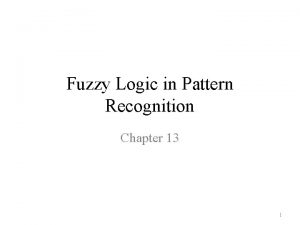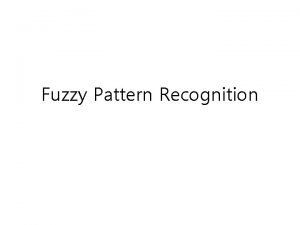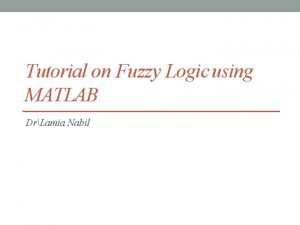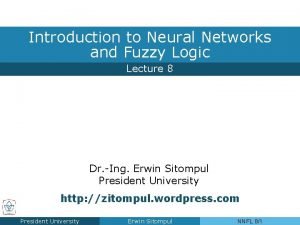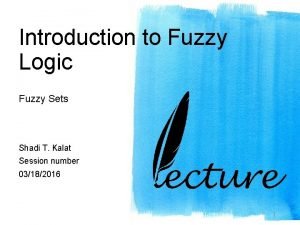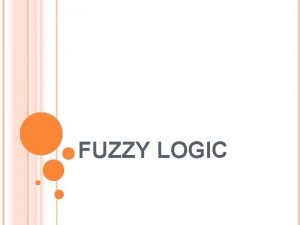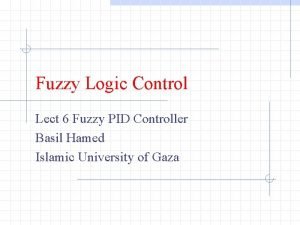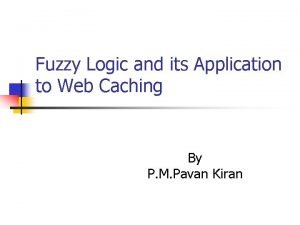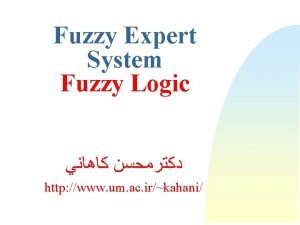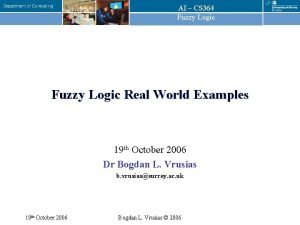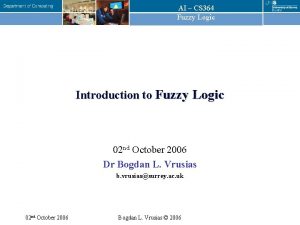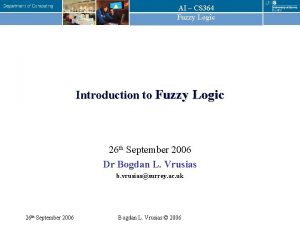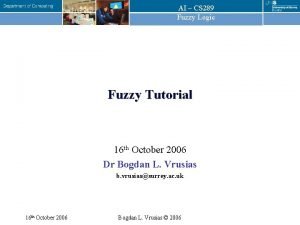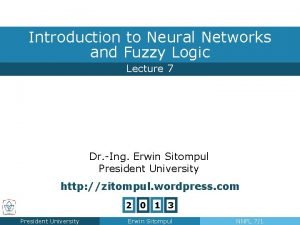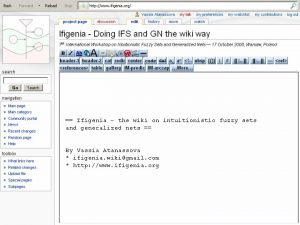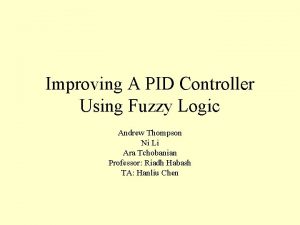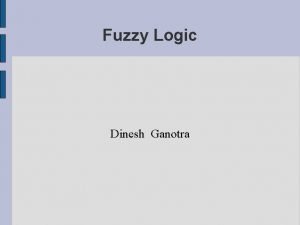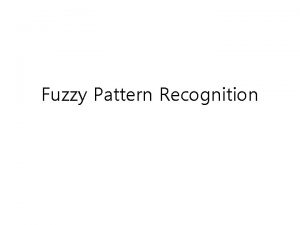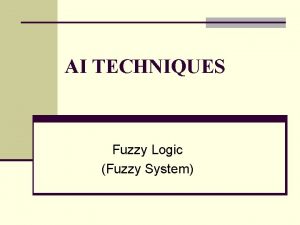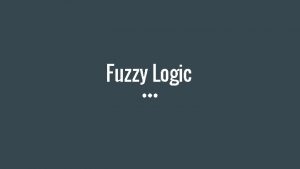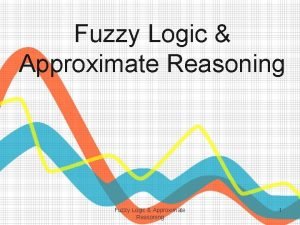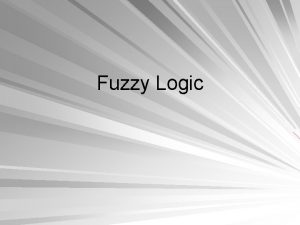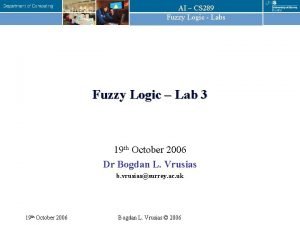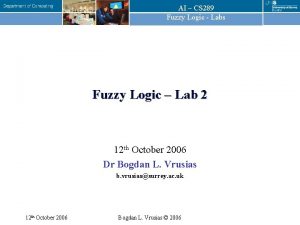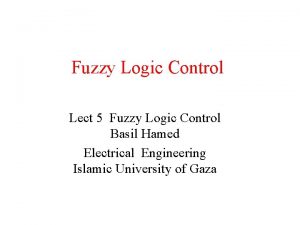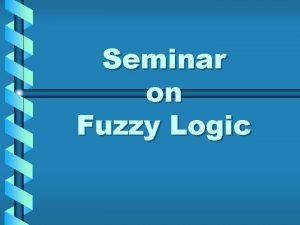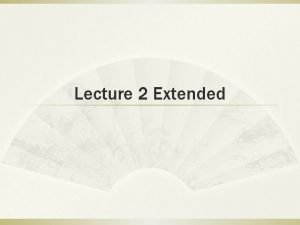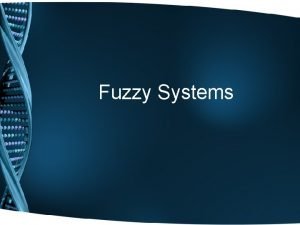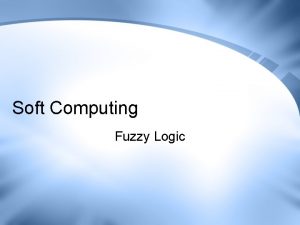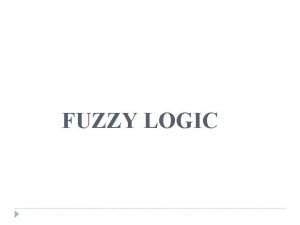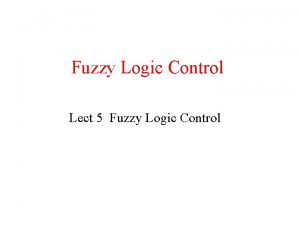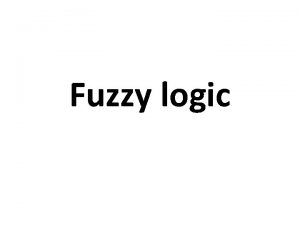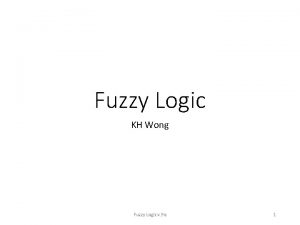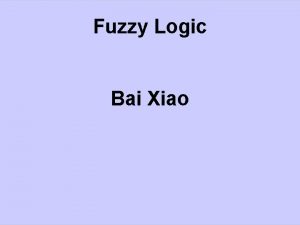Fuzzy Logic in Pattern Recognition Chapter 13 1




















- Slides: 20

Fuzzy Logic in Pattern Recognition Chapter 13 1

Introduction • Pattern recognition techniques can be classified into two broad categories – unsupervised (非監督式) techniques : Clustering. – supervised (監督式) techniques : Classification. • An unsupervised technique use a given set of unclassified data points, where as a supervised technique uses a dataset with known classifications. 2

Unsupervised Clustering • Unsupervised clustering is motivated by the need to find interesting patterns or groupings in a given set of data. – Used to perform the task of “segmenting” the images. (*i. e. , partitioning pixels on an image into regions that correspond to different objects in the image) 3

Unsupervised Clustering • Let X be a set of data, and xi be an element of X. A partition P={c 1, c 2, …, cl}of X is “hard” if and only if – (the partition covers all data points in X) – (all clusters in the partition are mutually exclusive) 4

Unsupervised Clustering • In many real-world clustering problems, some data points partially belong to multiple clusters, rather than to a single cluster exclusive. • Let X be a set of data, and xi be an element of X. A partition P={c 1, c 2, …, cl} of X is “soft” if and only if – – where cluster cj denotes the degree to which xi belong to 5

Unsupervised Clustering • A type of soft clustering of special interest is one that ensures the membership degree of a point X in all clusters adding up to one 6

The (Hard) C-Means Algorithm • The hard c-means algorithm aims to identify compact, well-separated clusters • A compact cluster has a “ball-like” shape. The center of the ball is called the center or the prototype of the cluster • A set of clusters are well separated when any two points in a cluster are closer than the shortest distance between two clusters in different clusters. 7

The (Hard) C-Means Algorithm • Examples (1) (2) 8

The (Hard) C-Means Algorithm • The goals of hard c-means algorithm is twofold – To find the centers of these clusters • Calculating the current partition based on the current cluster • Modifying the current centers using a gradient descent method to minimize the J function 9

The (Hard) C-Means Algorithm – To determine the clusters (i. e, labels) of each point in the data set Where vj denotes the center of the cluster cj 10

The (Hard) C-Means Algorithm The hard C-Means algorithm Step 1: Calculating the current partition based on the current cluster. Step 2: Modifying the current cluster centers using a gradient descent method to minimize the J function. 11

Fuzzy C-means Algorithm • The fuzzy c-means algorithm (FCM) generalizes the hard c-means algorithm to allow a point to partially belong to multiple clusters. 12

Fuzzy C-means Algorithm • Fuzzy c-means algorithm Initialize prototype V={v 1, v 2, …, vc} (每一群中心) Repeat Vprevious V compute membership functions using 13

Fuzzy C-means Algorithm • Update the prototype, vj in V using until 14

Fuzzy C-means Algorithm • Example 15

Fuzzy C-means Algorithm • The dataset are partitioned into two clusters 16

Classifier Design and Supervised Pattern Recognition • Supervised pattern recognition uses data with known classifications, which are also called labeled data, to determine the classification of new data. • The main benefit of unsupervised pattern recognition techniques is that they do not require training data; however, their computation time is relatively high due to a large number of iterations (疊代) needed before the algorithm converges. 17

Classifier Design and Supervised Pattern Recognition • A supervised pattern recognition technique is relatively fast because it does not need to iterate; however, it cannot be applied to a problem unless training data or relevant knowledge are available. 18

K-Nearest Neighborhood(K-NN) • The main advantage of K-NN is its computational simplicity. • It has two major problems – Each of the neighbors is considered equally important in determining the classification of the input data. A far neighbor is given the same weight as a close neighbor of the input. – The algorithm only assigns a class to the input data, it does not determine the “strength” of membership in the class. 19

Fuzzy K-Nearest Neighborhood • Fuzzy K-NN contains two steps – Find the K-nearest neighbors of the input x – Calculate the class membership of x using 20
 Fuzzy logic in pattern recognition
Fuzzy logic in pattern recognition Fuzzy sets and fuzzy logic theory and applications
Fuzzy sets and fuzzy logic theory and applications Fuzzy classification in pattern recognition
Fuzzy classification in pattern recognition Tipping problem fuzzy logic
Tipping problem fuzzy logic Contoh himpunan fuzzy
Contoh himpunan fuzzy Fuzzy logic lecture
Fuzzy logic lecture Fuzzy logic lecture
Fuzzy logic lecture Algebraic sum of fuzzy sets
Algebraic sum of fuzzy sets Fuzzy definition
Fuzzy definition Fuzzy logic controller
Fuzzy logic controller What is linguistic variables in fuzzy logic
What is linguistic variables in fuzzy logic Fuzzy logic examples
Fuzzy logic examples Fuzzy logic examples from real world
Fuzzy logic examples from real world The washington fuzzy cs
The washington fuzzy cs What is linguistic variables in fuzzy logic
What is linguistic variables in fuzzy logic Fuzzy logic tutorial
Fuzzy logic tutorial Fuzzy logic lecture
Fuzzy logic lecture Intuitionistic fuzzy sets wikipedia
Intuitionistic fuzzy sets wikipedia Fuzzy logic
Fuzzy logic Fuzzy logic
Fuzzy logic Fuzzy logic
Fuzzy logic
